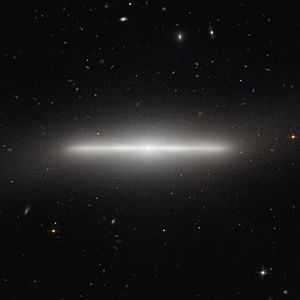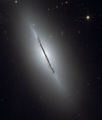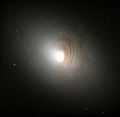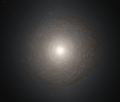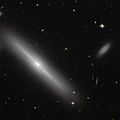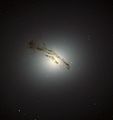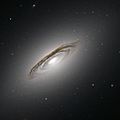Lenticular galaxy facts for kids
A lenticular galaxy is a special type of galaxy that looks a bit like a lens or a frisbee. Imagine a mix between a spiral galaxy (which has arms like a pinwheel) and an elliptical galaxy (which is shaped like a giant egg or ball). Lenticular galaxies have a flat, disk-like shape, but they don't have clear spiral arms. They often have a bright bulge in the middle, just like spiral galaxies.
Contents
What Makes Them Special?
Lenticular galaxies are sometimes called "S0" galaxies. This name comes from the Hubble Tuning Fork diagram, which is a way scientists classify galaxies based on their shape. They have a flat disk, like a spiral galaxy, but they don't have the swirling arms that make spiral galaxies so famous. They also have a central bulge, which is a big, bright group of stars in the middle.
How They Look
When you look at a lenticular galaxy, you'll see that it's mostly made of older stars. This is because they have very little gas and dust left. Gas and dust are the building blocks for new stars, so without much of it, new stars don't form very often in these galaxies. This makes them look less blue and more yellowish or reddish compared to spiral galaxies, which are often full of young, blue stars.
Where They Are Found
Lenticular galaxies are often found in crowded places in space, like in the middle of big groups of galaxies called galaxy clusters. Scientists think that these busy environments might play a role in how lenticular galaxies form.
How Lenticular Galaxies Form
Scientists have a few ideas about how lenticular galaxies come to be.
Spiral Galaxies Losing Their Gas
One idea is that they start out as spiral galaxies. Over time, these spiral galaxies might lose their gas and dust. This can happen if they crash into other galaxies, or if the gas is stripped away by the hot gas in a galaxy cluster. Without gas and dust, the spiral arms fade away, and the galaxy stops making many new stars, turning into a lenticular galaxy.
Merging Galaxies
Another idea is that lenticular galaxies form when two spiral galaxies crash into each other and merge. When galaxies merge, their shapes can change dramatically. The collision can use up or push out the gas and dust, leading to a new galaxy that has a disk but no clear spiral arms.
Comparing Galaxy Types
It can sometimes be tricky to tell the difference between a lenticular galaxy, a spiral galaxy, and an elliptical galaxy.
- Spiral Galaxies: These have a flat disk, a central bulge, and clear spiral arms where new stars are forming. They have lots of gas and dust.
- Elliptical Galaxies: These are shaped like a ball or an egg. They don't have a disk or spiral arms. They also have very little gas and dust and are mostly made of old stars.
- Lenticular Galaxies: These are in between. They have a disk and a bulge like spirals, but no spiral arms. Like ellipticals, they have very little gas and dust and mostly older stars.
Examples of Lenticular Galaxies
Some well-known examples of lenticular galaxies include the Cartwheel galaxy and NGC 4479. Many others have been observed by powerful telescopes like the Hubble Space Telescope.
Images for kids
-
The Spindle Galaxy (NGC 5866), a lenticular galaxy in the constellation Draco. This image shows that lenticular galaxies may retain a considerable amount of dust in their disk. There is little to no gas and thus they are considered deficient in interstellar matter.
-
NGC 2787 is an example of a lenticular galaxy with visible dust absorption. While this galaxy has been classified as an S0 galaxy, one can see the difficulty in differentiating among spirals, ellipticals, and lenticulars. Credit: HST
-
Lenticular galaxy NGC 5308 is located just under 100 million light-years away in the constellation of Ursa Major.
-
NGC 4111 is a lenticular galaxy, lying about 50 million light-years away in the constellation of Canes Venatici.
-
Messier 84 is a lenticular galaxy also known for its supernovae.
-
NGC 6861 is a lenticular galaxy discovered in 1826 by the Scottish astronomer James Dunlop.
See also
 In Spanish: Galaxia lenticular para niños
In Spanish: Galaxia lenticular para niños


